The Frictionless Remote Monitoring Devices Market is estimated to be valued at USD 379.7 million in 2025 and is projected to reach USD 1179.2 million by 2035, registering a compound annual growth rate (CAGR) of 12.0% over the forecast period.
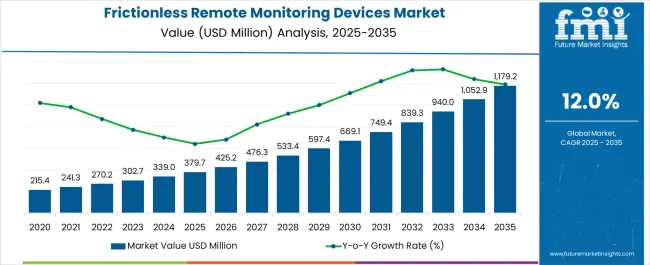
| Metric | Value |
|---|---|
| Frictionless Remote Monitoring Devices Market Estimated Value in (2025 E) | USD 379.7 million |
| Frictionless Remote Monitoring Devices Market Forecast Value in (2035 F) | USD 1179.2 million |
| Forecast CAGR (2025 to 2035) | 12.0% |
The frictionless remote monitoring devices market is experiencing accelerated expansion, supported by the growing emphasis on continuous health monitoring, patient-centric care models, and advancements in connected medical technologies. Rising prevalence of chronic diseases, particularly diabetes and cardiovascular disorders, is driving the adoption of devices that provide real-time data without invasive procedures. Healthcare providers are increasingly prioritizing solutions that improve patient compliance, reduce hospital visits, and enable data-driven decision-making through integration with digital health platforms.
The market is also benefiting from the growing role of telemedicine, which requires accurate and seamless data transfer from patients to physicians. Increasing awareness of preventive healthcare, coupled with greater willingness among patients to adopt wearable and non-invasive monitoring devices, is further shaping demand.
Technological innovations such as AI-powered analytics, cloud connectivity, and advanced biosensors are strengthening device performance and reliability As healthcare systems worldwide aim to lower costs while improving outcomes, frictionless remote monitoring devices are expected to gain deeper penetration, paving the way for sustained long-term growth across multiple regions and applications.
The frictionless remote monitoring devices market is segmented by product type, application, and geographic regions. By product type, frictionless remote monitoring devices market is divided into Glucose monitoring devices, Wrist bands, and Necklace. In terms of application, frictionless remote monitoring devices market is classified into Diabetes, High Blood Pressure, Calories, Fitness, Counting steps, Miles cycled, Floors climbed, Calories consumed, Heart rate, and Blood pressure. Regionally, the frictionless remote monitoring devices industry is classified into North America, Latin America, Western Europe, Eastern Europe, Balkan & Baltic Countries, Russia & Belarus, Central Asia, East Asia, South Asia & Pacific, and the Middle East & Africa.
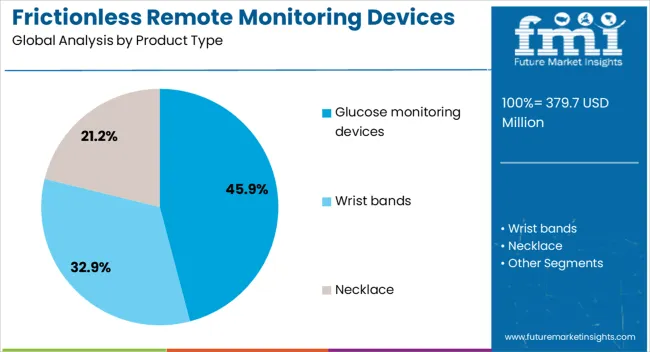
The glucose monitoring devices segment is projected to hold 45.9% of the frictionless remote monitoring devices market revenue share in 2025, making it the leading product type. Its leadership is being driven by the high global prevalence of diabetes and the growing importance of continuous glucose monitoring as a cornerstone of effective disease management. The shift from traditional finger-prick testing toward frictionless, non-invasive, and wearable devices is improving patient adherence and reducing barriers to regular monitoring.
Integration with mobile applications and cloud platforms is allowing patients and healthcare providers to track and analyze glucose data in real time, enhancing disease management strategies. Advancements in biosensor technologies and miniaturization are making devices more accurate, comfortable, and user-friendly, which is boosting adoption rates.
Rising government and healthcare initiatives aimed at improving diabetes care are also supporting widespread use of these devices As demand for long-term and efficient glucose management solutions continues to rise, this product type is expected to maintain its dominant share in the global market.
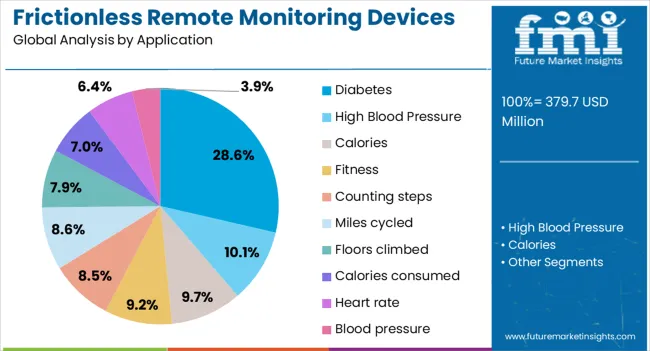
The diabetes application segment is anticipated to represent 28.6% of the frictionless remote monitoring devices market revenue share in 2025, making it the leading application category. This dominance is being supported by the increasing global diabetes population, which requires continuous and reliable monitoring to prevent complications and improve quality of life. The growing shift toward personalized healthcare and preventive care models is further reinforcing the need for frictionless devices that can provide accurate, real-time data without invasive procedures.
Adoption is being driven by patients seeking more convenient and less intrusive monitoring options, as well as healthcare providers who value the integration of these devices into broader disease management platforms. Advancements in connectivity and artificial intelligence are enabling more precise data interpretation, improving treatment outcomes and enabling proactive interventions.
Strong investment in diabetes management programs across both developed and developing economies is also driving growth As diabetes remains one of the most significant chronic health challenges worldwide, its role as the leading application segment is expected to remain firmly established in the market.
According to World Health Organization (WHO) accounts, 347 million people suffering from diabetes around the world and raised blood pressure is estimated to cause 7.5 million deaths around the world.
Traditional treatment for monitoring glucose in diabetic patients requires periodic poking with needles. Presently, advanced technologies are available to overcome traditional treatment problems. Needle free glucose monitoring devices, wearable devices, and biosensors are the examples for Frictionless Remote Monitoring Devices.
Wearable devices such as wrist bands, necklace are available for self-monitoring of health includes heart rate, miles cycled, calories consumed, and counting steps.
Frictionless remote monitoring device components include sensors, recorder and GPS systems, and mobile phones. Using of frictionless remote monitoring devices reduces the hospitalization by providing the useful health data to the patient to monitor health themselves.
Presently, Frictionless Remote Monitoring Devices Market are driven by increasing the prevalence rate of chronic disorders such as diabetes and hypertension. Rapid growth in wireless technology, raised awareness among the people, increased geriatric population also drivers for Frictionless Remote Monitoring Devices Market.
The devices are also available in new styles with customization options, this is the new trend in frictionless remote monitoring devices market.
Health self-Monitoring Devices cost is very high, sometimes give wrong readings because of software problems and Mobile Apps disadvantage is the privacy of the patient's health information. Not all healthcare service providers can be trust worth.
With rapid growth in wireless technology and raised awareness about personal health care, the global Frictionless Remote Monitoring Devices Marketis expected to have a double digit growth in the forecast period (2025-2025).
The global Frictionless Remote Monitoring Devices Market is expected to register a double digit CAGR for the forecast period. Depending on geographic regions, global Frictionless Remote Monitoring Devices Market is segmented into seven key regions: North America, South America, Eastern Europe, Western Europe, Asia Pacific excluding Japan, Japan and Middle East & Africa.
North America dominates the global Frictionless Remote Monitoring Devices Market due to the technical advancements and good awareness of healthcare in people. Europe occupies second place in this market due to well healthcare setup and good awareness about health. Asia Pacific is expected to grow at a remarkable CAGR.
Some of the key players in Frictionless Remote Monitoring Devices Market are
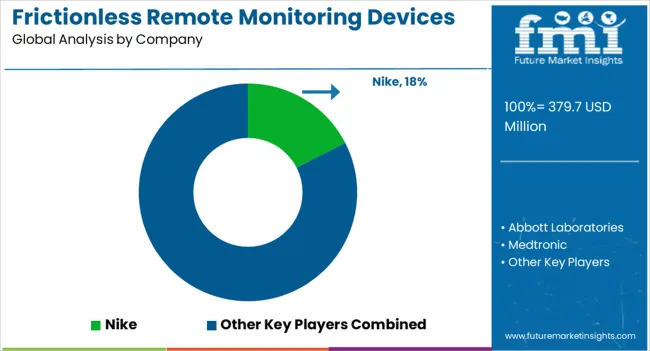
The research report presents a comprehensive assessment of the market and contains thoughtful insights, facts, historical data, and statistically supported and industry-validated market data. It also contains projections using a suitable set of assumptions and methodologies. The research report provides analysis and information according to categories such as market segments, geographies, types, technology and applications.
The report is a compilation of first-hand information, qualitative and quantitative assessment by industry analysts, inputs from industry experts and industry participants across the value chain. The report provides in-depth analysis of parent market trends, macro-economic indicators and governing factors along with market attractiveness as per segments. The report also maps the qualitative impact of various market factors on market segments and geographies.
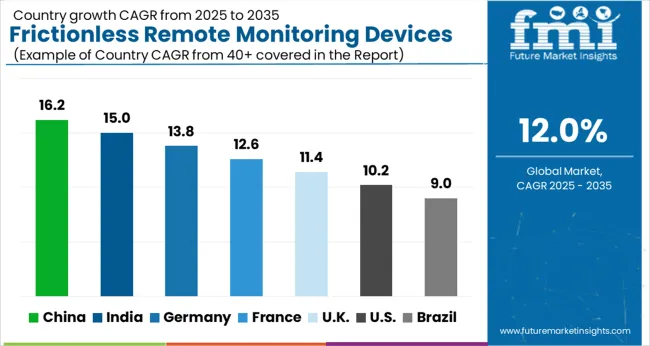
| Country | CAGR |
|---|---|
| China | 16.2% |
| India | 15.0% |
| Germany | 13.8% |
| France | 12.6% |
| UK | 11.4% |
| USA | 10.2% |
| Brazil | 9.0% |
The Frictionless Remote Monitoring Devices Market is expected to register a CAGR of 12.0% during the forecast period, exhibiting varied country level momentum. China leads with the highest CAGR of 16.2%, followed by India at 15.0%. Developed markets such as Germany, France, and the UK continue to expand steadily, while the USA is likely to grow at consistent rates. Brazil posts the lowest CAGR at 9.0%, yet still underscores a broadly positive trajectory for the global Frictionless Remote Monitoring Devices Market. In 2024, Germany held a dominant revenue in the Western Europe market and is expected to grow with a CAGR of 13.8%. The USA Frictionless Remote Monitoring Devices Market is estimated to be valued at USD 140.2 million in 2025 and is anticipated to reach a valuation of USD 370.2 million by 2035. Sales are projected to rise at a CAGR of 10.2% over the forecast period between 2025 and 2035. While Japan and South Korea markets are estimated to be valued at USD 19.3 million and USD 12.3 million respectively in 2025.
| Item | Value |
|---|---|
| Quantitative Units | USD 379.7 Million |
| Product Type | Glucose monitoring devices, Wrist bands, and Necklace |
| Application | Diabetes, High Blood Pressure, Calories, Fitness, Counting steps, Miles cycled, Floors climbed, Calories consumed, Heart rate, and Blood pressure |
| Regions Covered | North America, Europe, Asia-Pacific, Latin America, Middle East & Africa |
| Country Covered | United States, Canada, Germany, France, United Kingdom, China, Japan, India, Brazil, South Africa |
| Key Companies Profiled | Nike, Abbott Laboratories, Medtronic, Fitbit, LG Electronics, iHealth Lab Inc, Dexicom, and Philips Healthcare |
The global frictionless remote monitoring devices market is estimated to be valued at USD 379.7 million in 2025.
The market size for the frictionless remote monitoring devices market is projected to reach USD 1,179.2 million by 2035.
The frictionless remote monitoring devices market is expected to grow at a 12.0% CAGR between 2025 and 2035.
The key product types in frictionless remote monitoring devices market are glucose monitoring devices, wrist bands and necklace.
In terms of application, diabetes segment to command 28.6% share in the frictionless remote monitoring devices market in 2025.






Our Research Products

The "Full Research Suite" delivers actionable market intel, deep dives on markets or technologies, so clients act faster, cut risk, and unlock growth.

The Leaderboard benchmarks and ranks top vendors, classifying them as Established Leaders, Leading Challengers, or Disruptors & Challengers.

Locates where complements amplify value and substitutes erode it, forecasting net impact by horizon

We deliver granular, decision-grade intel: market sizing, 5-year forecasts, pricing, adoption, usage, revenue, and operational KPIs—plus competitor tracking, regulation, and value chains—across 60 countries broadly.

Spot the shifts before they hit your P&L. We track inflection points, adoption curves, pricing moves, and ecosystem plays to show where demand is heading, why it is changing, and what to do next across high-growth markets and disruptive tech

Real-time reads of user behavior. We track shifting priorities, perceptions of today’s and next-gen services, and provider experience, then pace how fast tech moves from trial to adoption, blending buyer, consumer, and channel inputs with social signals (#WhySwitch, #UX).

Partner with our analyst team to build a custom report designed around your business priorities. From analysing market trends to assessing competitors or crafting bespoke datasets, we tailor insights to your needs.
Supplier Intelligence
Discovery & Profiling
Capacity & Footprint
Performance & Risk
Compliance & Governance
Commercial Readiness
Who Supplies Whom
Scorecards & Shortlists
Playbooks & Docs
Category Intelligence
Definition & Scope
Demand & Use Cases
Cost Drivers
Market Structure
Supply Chain Map
Trade & Policy
Operating Norms
Deliverables
Buyer Intelligence
Account Basics
Spend & Scope
Procurement Model
Vendor Requirements
Terms & Policies
Entry Strategy
Pain Points & Triggers
Outputs
Pricing Analysis
Benchmarks
Trends
Should-Cost
Indexation
Landed Cost
Commercial Terms
Deliverables
Brand Analysis
Positioning & Value Prop
Share & Presence
Customer Evidence
Go-to-Market
Digital & Reputation
Compliance & Trust
KPIs & Gaps
Outputs
Full Research Suite comprises of:
Market outlook & trends analysis
Interviews & case studies
Strategic recommendations
Vendor profiles & capabilities analysis
5-year forecasts
8 regions and 60+ country-level data splits
Market segment data splits
12 months of continuous data updates
DELIVERED AS:
PDF EXCEL ONLINE
Remote Patient Monitoring Devices Market Size and Share Forecast Outlook 2025 to 2035
Cardiac Rhythm Remote Monitoring Devices Market Size and Share Forecast Outlook 2025 to 2035
Remote ICU Monitoring System Market Size and Share Forecast Outlook 2025 to 2035
Remote Home Monitoring Systems Market Size and Share Forecast Outlook 2025 to 2035
Remote Patient Monitoring System Market Size and Share Forecast Outlook 2025 to 2035
Remote Fertigation Monitoring Services Market
Pain Monitoring Devices Market Size and Share Forecast Outlook 2025 to 2035
Dose Monitoring Devices Market - Growth & Demand 2025 to 2035
Remote Endarterectomy Devices Market Size and Share Forecast Outlook 2025 to 2035
Noise Monitoring Devices Market Size and Share Forecast Outlook 2025 to 2035
Nerve Monitoring Devices Market Insights - Growth & Forecast 2025 to 2035
Remote Electrocardiogram Monitoring Market Size and Share Forecast Outlook 2025 to 2035
Lactate Monitoring Devices Market Size and Share Forecast Outlook 2025 to 2035
Patient Monitoring Devices Market Size and Share Forecast Outlook 2025 to 2035
Epilepsy Monitoring Devices Market Growth - Trends & Forecast 2025 to 2035
Compliance Monitoring Devices Market Trends and Forecast 2025 to 2035
Vital Signs Monitoring Devices Market Analysis - Trends & Forecast 2025 to 2035
Blood Glucose Monitoring Devices Market Size and Share Forecast Outlook 2025 to 2035
Connected RHM (Remote Healthcare Monitoring) Market Size and Share Forecast Outlook 2025 to 2035
Demand for Glucose Monitoring Devices in EU Size and Share Forecast Outlook 2025 to 2035

Thank you!
You will receive an email from our Business Development Manager. Please be sure to check your SPAM/JUNK folder too.
Chat With
MaRIA